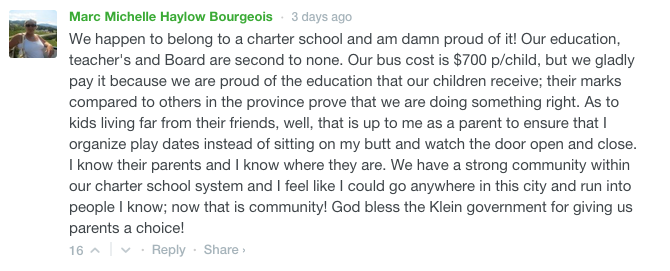Friday Freakout: School Choice? But What About Transportation?
It’s rare to see truly novel arguments against school choice, so I’ve got to give Canadian journalist Jeremy Klaszus credit for creativity this week in his Metro News article “How Calgary’s streamed schools have devalued our neighbourhoods.”
Klazsus is vexed because Calgary parents are choosing schools other than those that just happen to be closest to their home, and that is driving up bus fares and ruining the neighborhood.
He begins by lamenting that Calgary isn’t more like Toronto, where things are simpler (a word he appears to conflate with “better”):
“In Toronto and many other cities, when you register a kid for school, it’s pretty simple. You go to your local school—that’s what they call it, a “local school”—and register the kid.”
Some might find it odd that a journalist who claims to “specialize in people stories” fails to acknowledge that parents might value other aspects of a school more than its physical proximity. Does Klaszus choose his doctor, grocer, or barber this way? Some might. Many don’t. Proximity is a nice feature, but far from the most important one. Why should we expect that any one school can best meet the needs of all the students in a given geographic area?
Unlike Torontonians, Klaszus points out Calgary parents can choose from a “plethora of ‘designated schools,’ including alternative programs such as science schools, language schools, gender-specific schools and ‘traditional learning centres’ located throughout the city.” All these choices mean that “students criss-cross the city to get to and from school.”
Klaszus claims the “great cost” of all the school choice crissing and crossing is that it has driven up bus fees $35 dollars a year per student—nearly $4 per each month of the school year.
“In a city with Calgary’s size, population and growth rate, this design comes at great cost. This year, CBE bus fees rose to $330, up from $295. Bus companies struggle to recruit enough drivers. Kids travel further to bus stops. Parents complain of buses showing up late or not showing up at all.
In other words, parents are paying more for an increasingly strained bus system. This is the price of choice.”
Klaszus provides no evidence to show school choice is responsible for the 12 percent hike in bus fares (as opposed to, say, the rising price of fuel). And if buses aren’t showing up on time or at all, is it more reasonable to fault the Calgary Board of Education bus management team or the parents?
After blaming school choice for a few questionably related inconveniences based on nothing but his feelings, Klaszus touches on a more reasonable concern:
“There’s a social cost, too. In our neighbourhood, kids who have grown up playing together from infancy onward are now scattered every which way, attending different schools.
As a result, the kids don’t see each other as much and neither do the parents. The social fabric of our neighbourhood is weaker.”
Every policy has tradeoffs, and school choice advocates must be open to the possibility that school choice will upset and possibly even weaken the social fabric of a given neighborhood. For example, Andy Smarick has written thoughtfully about the potentially negative consequences to a community of closing down “failing” schools.
But nor should school choice critics be blind to the ways choice can strengthen the social fabric. After all, as Alexis de Tocqueville observed, it is through our voluntary associations that we achieve “the highest perfection” of “the art of pursuing in common the object of [our] common desires.” So, if we choose to connect with our neighbors, we are more likely to achieve strong, healthy communities than if we rely on a school (and a system that forces our kids to attend it) to bring us together.
One commenter on Klaszus’ article explained:

Of course, not every school requires $700 annual transport fees, but indeed some do. In America at least, it is common for non-public schools of choice to coordinate transportation with parents in need of assistance. That could look like anything from public transportation vouchers to connecting parents for carpooling to reimbursement for gas/mileage.
In the end, if proximity to home is a top priority for a school choice parent, they have complete freedom to choose a school closer to home. Research shows, however, that school choice parents’ top reasons for choosing their children’s schools are: better student discipline, better learning environment, smaller class sizes, improved student safety, and more individual attention.
Moreover, because neighborhoods are so often divided along racial and socio-economic lines, school choice may well break down the barriers between what political scientist Charles Murray calls “Belmont and Fishtown.” In a similar vein, studies show that school choice students tend to shift from more segregated schools to more integrated schools.
Despite lacking literally any evidence to support his claims, Klaszus nevertheless concludes: “Choice, it turns out, may not be worth the cost.” What that cost is and at what point it becomes too high, he does not make clear. All that’s clear is that he does not believe it should be for parents to decide.




